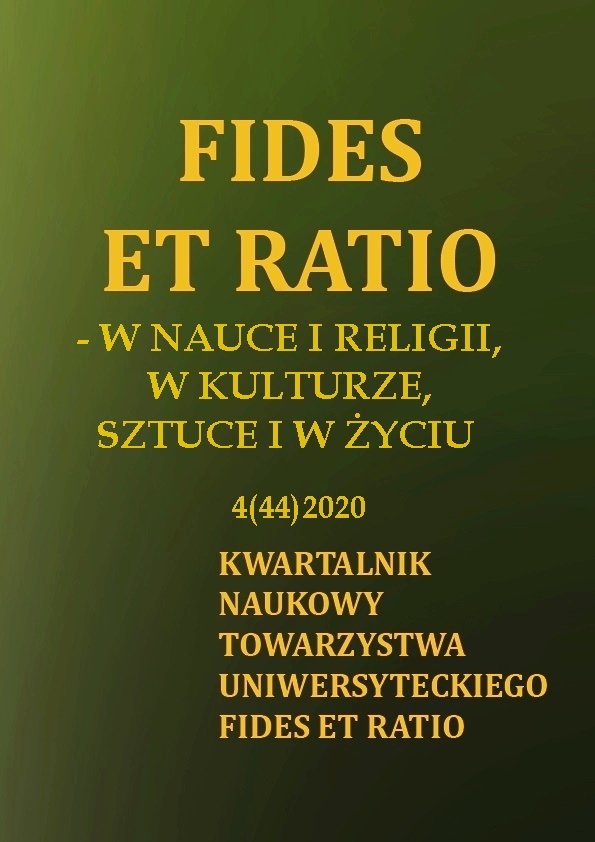Abstract
The concept of the cognitive function of religious art as defined by John Paul II is a remarkable proposition within contemporary theological aesthetics. It should be analyzed in the perspective of the creationist vision of man and the world. Man, as created in the image and likeness of God, is by nature a creator, since God is the Creator of the whole world. Every person is called to responsible self-determination, which makes him the author of his own life. Apart from universal creativity understood in this way, the Pope also distinguished the exceptional vocation of an artist who has an important role to play in society, culture and nation, in connection with the cognitive abilities of art. The artist, showing in his art new epiphanies of beauty, being inspired by motives from the Holy Scriptures, communicates the truth about the destiny of man and God. Knowledge through art, enriching knowledge through faith, satisfies the human need for meaning related to the desire to know the truth. The cognitive function of art in the presented concept is anthropogenic. By getting to know the truth with the participation of art, man realizes his own being in an ever more complete way. There is a strict dependence - by creating art, man builds humanity in man.
ut the destiny of man and God. Knowledge through art, enriching knowledge through faith, satisfies the human need for meaning related to the desire to know the truth. The cognitive function of art in the presented concept is anthropogenic. By getting to know the truth with the participation of art, man realizes his own being in an ever more complete way. There is a strict dependence - by creating art, man builds humanity in man.
References
Gadomska-Serafin, R. 2012, Promethidion Cypriana Norwida i List do artystów Jana Pawła II, czyli rozważania o pięknie prawdziwym, Tematy i Konteksty, 2 (7), 372-398.
Jan Paweł II. 1998. Encyklika Fides et Ratio Ojca Świętego Jana Pawła II do Biskupów Kościoła Katolickiego o relacjach między wiarą a rozumem, Kraków: Wydawnictwo Św. Stanisława BP Archidiecezji Krakowskiej.
Jan Paweł II. 1999. List Ojca Świętego Jana Pawła II do Artystów, Częstochowa: Tygodnik Katolicki Niedziela.
Jaroszyński, P. (1996). Metafizyka i sztuka, Warszawa: Wydawnictwo Tadeusza Radjusza „Gutenberg -Print”.
Kiereś, H. (1994). Sztuka a prawda, Człowiek w kulturze, 2, 51-69.
Kiereś, H. (1995). Sztuka religijna czy sacrum w sztuce, Człowiek w kulturze, 6-7, 313-330.
Kiereś, H. (1996). Spór o sztukę, Lublin: TN KUL.
Moskal, P. (2014). Traktat o religii, Lublin: Wydawnictwo KUL.
Seirbet, J. (2007). Leksykon sztuki chrześcijańskiej. Tematy, postaci, symbole, Kielce: Wydawnictwo Jedność.
Sieńkowski, M. (2014). Wiara a inne typy poznania, Civitas et Lex, 4, 69-81.
Tytko, M.M. (2013). Artysta w koncepcji Jana Pawła II w Liście do artystów, Religious and Sacred Poetry: An International Quarterly of Religion, Culture and Education, 1/2, 117-142.
Zdybicka, Z.J. (2009). Jan Paweł II filozof i mistyk, Lublin: Polskie Towarzystwo Tomasza z Akwinu.
Konstytucja duszpasterska o Kościele w świecie współczesnym (Gaudium et Spes), Znak, 148 (10) 1966.
Pismo Święte Starego i Nowego Testamentu. Najnowszy przekład z języków oryginalnych z komentarzem. (2009). Częstochowa: Edycja Świętego Pawła.
Powszechna Encyklopedia Filozofii, 9 (2008), Lublin: Polskie Towarzystwo Tomasza z Akwinu. https://encyklopedia.pwn.pl/haslo/sztuka-religijna;3983510.html (data dostępu: 15.08.2020).
Gadomska-Serafin, R. (2012). Promethidion Cypriana Norwida i List do artystów Jana Pawła II, czyli rozważania o pięknie prawdziwym, Tematy i Konteksty, 2 (7), 372-398.
Jan Paweł II. (1998). Encyklika Fides et Ratio Ojca Świętego Jana Pawła II do Biskupów Kościoła Katolickiego o relacjach między wiarą a rozumem, Kraków: Wydawnictwo Św. Stanisława BP Archidiecezji Krakowskiej.
Jan Paweł II. (1999). List Ojca Świętego Jana Pawła II do Artystów, Częstochowa: Tygodnik Katolicki Niedziela.
Jaroszyński, P. (1996). Metafizyka i sztuka, Warszawa: Wydawnictwo Tadeusza Radjusza „Gutenberg -Print”.
Kiereś, H. (1994). Sztuka a prawda, Człowiek w kulturze, 2, 51-69.
Kiereś, H. (1995). Sztuka religijna czy sacrum w sztuce, Człowiek w kulturze, 6-7, 313-330.
Kiereś, H. (1996). Spór o sztukę, Lublin: TN KUL.
Moskal, P. (2014). Traktat o religii, Lublin: Wydawnictwo KUL.
Seirbet, J. (2007). Leksykon sztuki chrześcijańskiej. Tematy, postaci, symbole, Kielce: Wydawnictwo Jedność.
Sieńkowski, M. (2014). Wiara a inne typy poznania, Civitas et Lex, 4, 69-81.
Tytko, M.M. (2013). Artysta w koncepcji Jana Pawła II w Liście do artystów, Religious and Sacred Poetry: An International Quarterly of Religion, Culture and Education, 1/2, 117-142.
Zdybicka, Z.J. (2009). Jan Paweł II filozof i mistyk, Lublin: Polskie Towarzystwo Tomasza z Akwinu.
Konstytucja duszpasterska o Kościele w świecie współczesnym (Gaudium et Spes), Znak, 148 (10) 1966.
Powszechna Encyklopedia Filozofii, 9 (2008), Lublin: Polskie Towarzystwo Tomasza z Akwinu, za: https://encyklopedia.pwn.pl/haslo/sztuka-religijna;3983510.html (data dostępu: 15.08.2020).

